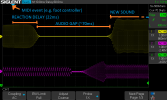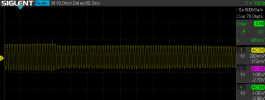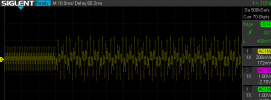BobXX
Inspired
6 oct 2023 - IMPORTANT UPDATE:
I'm crazy happy that Version 23.00 public beta 1 announced:












[ Part 1 here - Measurements and Info ] current
[ Part 2 here - Measurements and Info ]
[ Part 3 here - Measurements and Info ]
[ Part 4 here - Tips & Tricks ]
[ Part 5 here - Tips & Tricks ]
[ Part 6 here - Tips & Tricks - GAP "FILLER": GAPLESS Proof of Concept ]
It's known there's always a sound gap when switching presets, I've measured it between 18ms (switching to an empty preset) to ~80ms (switching to an 80% CPU preset).
See this sample test to understand the other pictures:

I've passed from a couple of 18 yrs old rackmount BOSS GT-PRO to a new FRACTAL AXE FX3 TURBO, in this picture you can see in YELLOW the trace referring to FRACTAL AF3 and in MAGENTA the trace referring to the old BOSS GT-PRO.
We can see that reaction time is much faster in AF3 (22ms) whilst BOSS have a much slower reaction time, up to to a 65ms... but BOSS' audio gaps never go over 15ms, even switching complex Presets.
AF3 blocks (especially AMPs) are much more complex and powerful than old BOSS ones, but BOSS' CPUs are also old and much less powerful than AF3. So I admit I expected not to have gaps, at least shorter than BOSS'. That's why I needed to get rid of them somehow.
To have gapless switching sounds some suggest to stay within the same Preset, just switching scenes/channels and use modifiers.
It helps, but you may still get audio gaps.
For some type of block the scene/channel change can induce a gap. Its amount depends on more factors that we will see.
TIP for beginners:
For people used to switch presets from the foot controller, AF3's PC Mapping (SETUP-MIDI Remote) allows to associate a MIDI PC command to the same Preset and a different Scene, so it's easy to switch Scenes from an external standard Foot Controller.
The specific option "Ignore Redundant PC" eliminates the gap caused by uselessly reloading the same Preset.
"GAPLESS" BLOCKS:
In my measurements these blocks don't create gaps when switching their scenes/channels:

Here's PLEX DELAY, after the reaction delay of 20ms (10 ms per division) you can see the audio continues seamlessly:

This is the case of a RING MODULATOR with different parameters set in two channels:

Again, no gaps at all !
(*) REACTION DELAYs
Typically is around 20ms. I measured it from 18ms (empty preset) up to 30ms for the more complex presets (@~ 80% CPU).
In my opinion they are OK, I'm much more concerned about the audio gaps.
"GAP TRIGGERING" BLOCKS:
ALL the other blocks do cause a GAP (I will show how to eliminate it for some of them), but their amount isn't linear and depends on more factors, two of them are:
So let's see the "gap inducing" blocks with their typical minimum GAP:
It was known that AMPs are the big beasts that cause the highest audio gap.
Let's see what happens switching channels of more blocks together:
I'm crazy happy that Version 23.00 public beta 1 announced:
"...Preset, Scene and Channel changes are now gapless."
https://forum.fractalaudio.com/threads/axe-fx-iii-firmware-23-00-public-beta-1.198479/#post-2467451












[ Part 1 here - Measurements and Info ] current
[ Part 2 here - Measurements and Info ]
[ Part 3 here - Measurements and Info ]
[ Part 4 here - Tips & Tricks ]
[ Part 5 here - Tips & Tricks ]
[ Part 6 here - Tips & Tricks - GAP "FILLER": GAPLESS Proof of Concept ]
- All my tests were done on a AXE FXIII MK2 TURBO, updated with FW v. 22.01
- I've tested all block types, in several combinations
- I've used professional instrumentation to verify what I heard with my ears,
finding interesting information and new tricks for Fractal users
- Foreword: I am an electronics engineer who has been working in sound engineering for years; I have worked positively with Korg, Scope, Roland, and Ibanez (I mean, they do implemented some of my ideas/requirements).
I am a rock/metal guitarist with an experience of 3 albums (few), many collaborations and +400 concerts, I think it's enough to have a possible good point of view of the requirements of a modern guitarist. I am far from being a Steve Vai though--but not a novice either.
I love my FRACTAL AXE FXIII MKII Turbo, my inner struggle is to set it as close to my needs as possible.
So, get out of your head that I am here to criticize, I just want to understand and find every possible solution, help/be helped. That's all.
- LATENCY: These posts aren't about latency, unless you're considering the audio gap as latency.
Latency is the system sound delay, typical of all digital systems, caused by input A/D (Analog to Digital) conversion, fixed processing, and final output D/A conversion.
AXE FXIII MKII TURBO has a latency of 2ms (0,002 seconds). Equivalent of staying 70cm farther from your amp.
It's known there's always a sound gap when switching presets, I've measured it between 18ms (switching to an empty preset) to ~80ms (switching to an 80% CPU preset).
See this sample test to understand the other pictures:
- blu triangle in the top is the starting point of Preset/Scene/Channel change request
- first part of the waveform is the previous sound, active for REACTION DELAY time until the system changes audio
- then there may be an AUDIO GAP: it's the stright line showing that there's no sound at all
- finally the NEW SOUND of a the new preset/scene/channel starts to be audible

I've passed from a couple of 18 yrs old rackmount BOSS GT-PRO to a new FRACTAL AXE FX3 TURBO, in this picture you can see in YELLOW the trace referring to FRACTAL AF3 and in MAGENTA the trace referring to the old BOSS GT-PRO.
We can see that reaction time is much faster in AF3 (22ms) whilst BOSS have a much slower reaction time, up to to a 65ms... but BOSS' audio gaps never go over 15ms, even switching complex Presets.
AF3 blocks (especially AMPs) are much more complex and powerful than old BOSS ones, but BOSS' CPUs are also old and much less powerful than AF3. So I admit I expected not to have gaps, at least shorter than BOSS'. That's why I needed to get rid of them somehow.
To have gapless switching sounds some suggest to stay within the same Preset, just switching scenes/channels and use modifiers.
It helps, but you may still get audio gaps.
For some type of block the scene/channel change can induce a gap. Its amount depends on more factors that we will see.
TIP for beginners:
For people used to switch presets from the foot controller, AF3's PC Mapping (SETUP-MIDI Remote) allows to associate a MIDI PC command to the same Preset and a different Scene, so it's easy to switch Scenes from an external standard Foot Controller.
The specific option "Ignore Redundant PC" eliminates the gap caused by uselessly reloading the same Preset.
"GAPLESS" BLOCKS:
In my measurements these blocks don't create gaps when switching their scenes/channels:


GAPLESS BLOCK | REACTION DELAY (ms) @ 10%CPU (*) | GAP (ms) |
| IN | 20 | 0 |
| OUT | 20 | 0 |
| CROSSOVER | 20 | 0 |
| DELAY | 20 | 0 |
| ENHANCER | 20 | 0 |
| FLANGER | 20 | 0 |
| FORMANT | 20 | 0 |
| GATE/EXP | 20 | 0 |
| MEGA TAP DELAY (whilst MULTI TAP DELAY does cause gaps) | 20 | 0 |
| MIXER | 20 | 0 |
| MULTIBAND COMPRESSOR | 20 | 0 |
| MPLEX | 20 | 0 |
| PITCH | 20 | 0 |
| PLEX DELAY | 20 | 0 |
| RESONATOR | 20 | 0 |
| REVERB | 20 | 0 |
| RING MODULATOR | 20 | 0 |
| ROTARY | 20 | 0 |
| TEN-TAP DELAY | 23 | 0 |
| VOCODER (it can't switch channels | 30 | 0 |
| TREMOLO | 20 | 0 |
| VOLUME/PAN | 20 | 0 |
| WAH | 21 | 0 |
Here's PLEX DELAY, after the reaction delay of 20ms (10 ms per division) you can see the audio continues seamlessly:

This is the case of a RING MODULATOR with different parameters set in two channels:

Again, no gaps at all !
(*) REACTION DELAYs
Typically is around 20ms. I measured it from 18ms (empty preset) up to 30ms for the more complex presets (@~ 80% CPU).
In my opinion they are OK, I'm much more concerned about the audio gaps.
"GAP TRIGGERING" BLOCKS:
ALL the other blocks do cause a GAP (I will show how to eliminate it for some of them), but their amount isn't linear and depends on more factors, two of them are:
- type of block, obvioulsy
- other concurrent channel changes
So let's see the "gap inducing" blocks with their typical minimum GAP:
GAP INDUCING BLOCK | minimum REACTION DELAY (ms) | minimum GAP (ms) |
| CAB (legacy) | 18 | 12 |
| CAB (dyna) | 18 | 15 |
| CHORUS | 18 | 12 |
| COMPRESSOR | 18 | 12 |
| DRIVE | 18 | 12 |
| DYNAMIC DISTORTION | 18 | 13 |
| FILTER | 18 | 12 |
| GRAPHIC EQ | 18 | 12 |
| IR PLAYER | 18 | 12 |
| MULTITAP DELAY (MEGA TAP DELAY is gapless) | 18 | 13 |
| PARAMETRIC EQ | 18 | 12 |
| PHASER | 18 | 12 |
| SYNTH | 18 | 12 |
| AMP | 19 | ~40 (Recto) |
| 2x AMPs (switching channels of both AMPs in a preset) | 19 | ~65 (Recto) |
It was known that AMPs are the big beasts that cause the highest audio gap.
Let's see what happens switching channels of more blocks together:
[ Part 2 here - Measurements and Info ]
Last edited:



 Hopefully your experiments will yield the changes or discussions you seek. Good luck.
Hopefully your experiments will yield the changes or discussions you seek. Good luck.